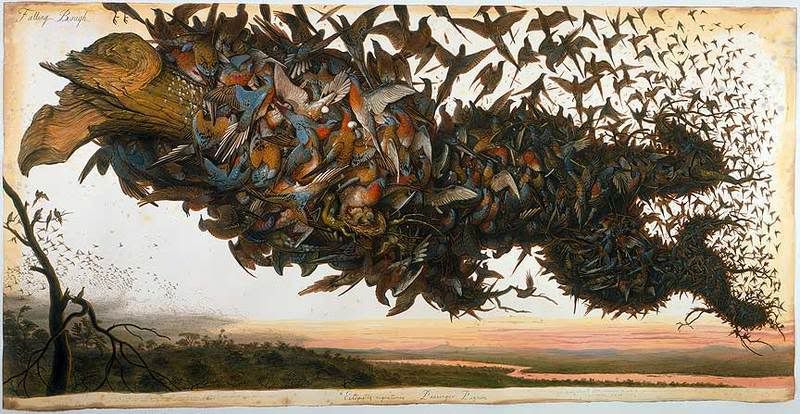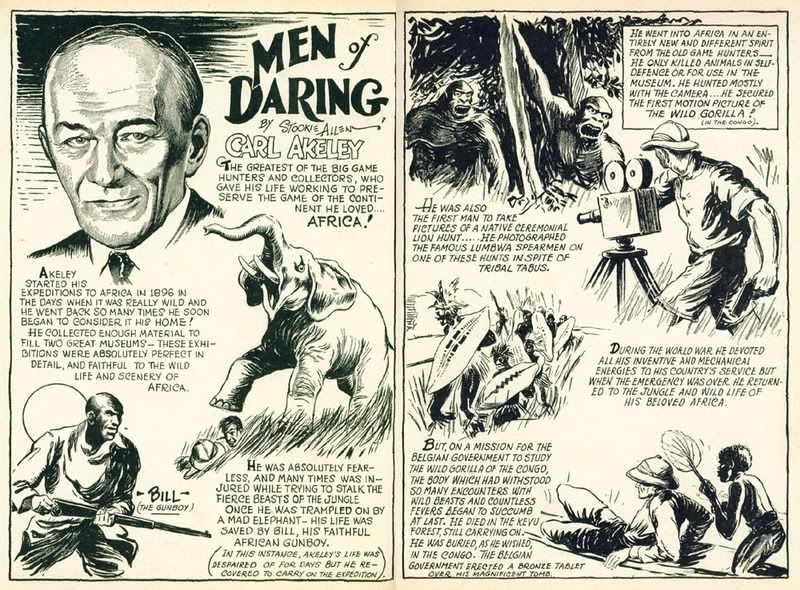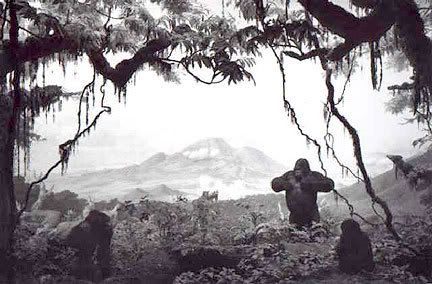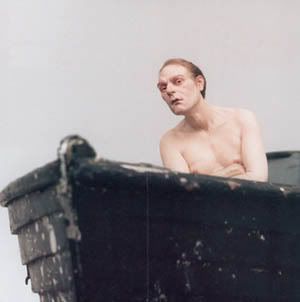

 I went to see the
I went to see the 


 Walton Ford exhibit, Tigers of Wrath, at the Brooklyn Museum yesterday. Fantastic! Ford creates gigantic watercolor paintings, often life-sized or larger, in the style of James Audubon with layers of subtext woven into them -- colonialism, destruction of natural resources, vanity, etc. I had wanted to see the show for some time but I got even more excited after speaking with Ted and Betsy Lewin at the Society. We quickly got around to talking about the Museum of Natural History and Carl Akeley. The Lewins told me that one of the Ford paintings was a tribute to Akeley and that meant that I had to run over as soon as I could.
Walton Ford exhibit, Tigers of Wrath, at the Brooklyn Museum yesterday. Fantastic! Ford creates gigantic watercolor paintings, often life-sized or larger, in the style of James Audubon with layers of subtext woven into them -- colonialism, destruction of natural resources, vanity, etc. I had wanted to see the show for some time but I got even more excited after speaking with Ted and Betsy Lewin at the Society. We quickly got around to talking about the Museum of Natural History and Carl Akeley. The Lewins told me that one of the Ford paintings was a tribute to Akeley and that meant that I had to run over as soon as I could.Carl Akeley is considered the father of modern taxidermy. He revolutionized the craft by expertly sculpting the musculature of the animals rather than limply stuffing the skins with straw. The American Museum of Natural History’s Hall of African Mammals was his vision and he died creating it. I’ve had a black and white photograph of the mountain gorilla group hanging on my office door for ages. The diorama not only depicts the landscape those gorillas lived and died in, it is also the place where Akeley was buried.
And when I say "the place", I mean that literally. One of the many things I love about those dioramas is that they are not representations of typical landscapes, they are exact replicas of a real place. Once a spot was chosen, every tree was caste and molded, plants were taken, grasses, dirt, reference paintings were done on site. Each diorama is a specific place at a specific time. When you see them (and the Hall of North American Mammals is no less stunning) you are looking at some of the finest landscape painting and animal sculpture possible, not to mention lighting design.
I love all the contradictions that the museum offers. Each of those specimens were shot and gutted (even the cute lil’ baby ones) and yet Akeley established the first park in Africa to protect the wildlife. The museum is a contemporary working science lab (the galleries take up a very small percentage of the buildings) even as it epitomizes a nineteenth century “great white hunter” esthetic. I also love that you can see exhibition design that has not been touched since the 50’s next to some fabulous contemporary design. (The only halls that I ever found ugly, the Hall of Human Biology are, thankfully, under renovation.)
Another exhibit we saw at the Brooklyn Museum was Ron Mueck’s hyper realistic sculptures of human bodies that have been enlarged or shrunk. I have to admit, before seeing the exhibit I wasn’t thinking too much of it...but in person, this show is amazing. The scale shifts, and flawless craft, jar you into reexamining the figure and quietly gasping at their humanity. These "people” are awkward, lonely, and fascinating.
Both shows, and the Natural History dioramas, rely on a mastery of their medium in order to be so effecting. (Very refreshing when so much contemporary art eschews technical ability.) Any flaw in the craft would have been a distraction from their artistic message. These exhibits can be visited over and over again... they are not intellectual puzzles to be “gotten” they are to be felt and experienced.
------
Lest you think this post is devoid of a science fiction connection, just a few minutes ago I learned j that James Tiptree Jr. went on expedition with Carl Akeley when she was six years old, or least that's what Wikipedia says.
------
IMAGES:
Walton Ford’s "Falling Bough" and detail. These paintings are often seven feet long or more. (There was even a life sized elephant painting.) Remarkable for watercolor. While the surface isn’t as deep and lush as a Charles Santore or Genady Spirin painting, the drawing and the value is spot on. What you lose in the looseness you more than make up for in the sheer presence of the work.
Various shots from the Museum of Natural History on a very busy New Years Day. I've been there a hundred times and still only leave when I'm kicked out. If you go, bring binoculars. It's a great way to rediscover the paintings.
A short bio, comic strip style, of Akeley that I found while looking for the the gorilla group photo below.
Photographer Hiroshi Sugimoto began his career with a series of photos of the dioramas in the 1970s. Here is the mountain gorilla group, depicting the burial ground of Carl Akeley.
Ron Mueck's sculptures “Man in a Boat” and the artist with "Dead Father." Since the whole point of these sculptures is the scale, you must see them in person. If given the chance, you won't regret the effort.